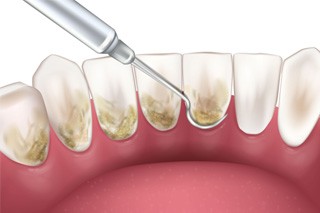Gum Disease Treatment - The Colony, TX
Protect Your Gums. Protect Your Health
 Gum disease. You’ve probably heard about it all your life, but did you know that it’s actually the most common dental problem in the entire world as well as the leading cause of tooth loss? At Ridgepointe Dental, Dr. Amos and the rest of our team take gum disease very seriously, so during your regular appointments, we will always keep an eye on your gum health. And if you do develop this condition, we’re here to help with appropriate forms of treatment! Call us today if you suspect that you’re suffering from gum disease.
Gum disease. You’ve probably heard about it all your life, but did you know that it’s actually the most common dental problem in the entire world as well as the leading cause of tooth loss? At Ridgepointe Dental, Dr. Amos and the rest of our team take gum disease very seriously, so during your regular appointments, we will always keep an eye on your gum health. And if you do develop this condition, we’re here to help with appropriate forms of treatment! Call us today if you suspect that you’re suffering from gum disease.
What is Gum Disease?

Gum disease is also referred to as periodontal disease. It is an infection of the gums that, when left untreated, can seriously damage the tissues responsible for keeping your teeth in place. Early gum disease (known as gingivitis) is relatively mild, but it can eventually lead to periodontitis, which is much more serious. Periodontitis can potentially cause you to lose your teeth, and it is also associated with a higher risk for heart disease and other health issues.
Symptoms of Gum Disease

Early on, gum disease is often silent, meaning it doesn’t show any noticeable symptoms. However, if you visit our office for routine dental checkups, we can check for signs of gum disease that you may have overlooked. You are more likely to notice symptoms as your gum disease grows more severe.
All that being said, there are some potential warning signs of gum disease you can keep an eye out for, such as:
- Swollen or red gums.
- Gums that tend to bleed easily.
- Persistent bad breath.
- Teeth that have come loose.
- Pain that occurs while you’re chewing your food.
- Gum recession that makes the teeth look longer than normal.
- Changes to your bite.
How Do We Treat Gum Disease?

Before anything else, we will need to examine your gums. It’s important for us to confirm that you are truly suffering from gum disease as well as to check to see how advanced the condition currently is. After making a diagnosis, we can create a treatment plan based on your specific circumstances. We encourage you to voice any questions or concerns you might have about the services we recommend.
Scaling & Root Planing

When gum disease is caught early enough, it can typically be treated using something called a “deep cleaning”, which consists of two separate procedures known as scaling and root planing. The scaling portion is meant to help get rid of the plaque and tartar contributing to your gum disease. Meanwhile, root planing can reduce your risk of reinfection.
What to Expect from Scaling & Root Planing

Your mouth will be numbed for the procedure. We will then begin the scaling process, which involves using special instruments to remove plaque and tartar from around and beneath the gumline. Once that’s done, we’ll move on to root planing, which involves smoothing out the roots of the teeth. Smoother roots make it harder for bacteria to build up in the future and can also aid with gum reattachment.
Is Scaling & Root Planing Painful?

The process of removing calcified plaque and bacteria from above and below the gums can be slightly discomforting, which is why we make sure to provide a local anesthetic ahead of your treatment. This removes any and all sensations during the procedure, ensuring you stay as comfortable as possible. The effects of the anesthetic will remain for the next few hours or so. If needed, you can also take advantage of nitrous oxide sedation to help keep you at ease during your appointment.
Recovering from Scaling & Root Planing

Once scaling and root planing are completed, the gums will need time to heal before any additional periodontal therapy can be performed. In most cases, about four to six weeks of healing are needed before any future treatments can be done at our office.
Dental Crown FAQs
Gum Disease Treatment FAQs
Can I Eat Anything After Completing Treatment?
You should avoid eating anything following the completion of scaling and root planing treatment until after the anesthesia has fully worn off. Not only are you more likely to experience sensitivity to hot and cold foods and beverages, but you can easily bite your tongue, cheek, and lips without realizing it. This can lead to cuts inside the mouth, which is the last thing you need following gum disease treatment.
Can Teeth Fall Out After Treatment?
Scaling and root planing do not cause teeth to become loose. This is because deep cleaning does not remove the part of the tooth that helps keep it attached to the gum and bone. This is known as the periodontal ligament, a portion that is only removed during a tooth extraction. However, if you do notice your tooth feeling loose following treatment, please call us right away.
How Often Will I Need to Visit Following My Treatment?
While patients with positive oral health only need to visit once every six months for routine exams and cleanings, those who need scaling and root planing will likely need to come in more often. This is because gum disease has the potential to come back when not carefully monitored. We will typically recommend that you visit us for additional treatment every three to four months.
